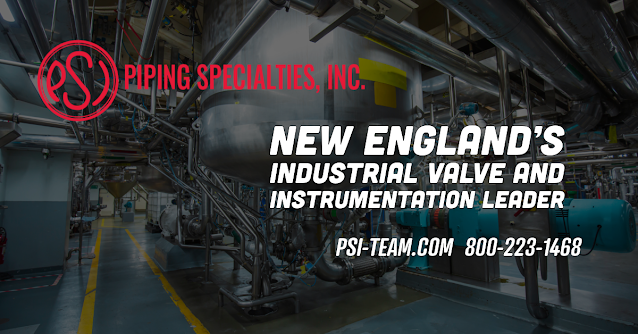Piping Specialties, Inc. (PSI), with offices in Portland, Maine, and Danvers, Massachusetts, has built a strong reputation across New England’s manufacturing industries. Since 1975, PSI has grown from a local valve supplier into a trusted partner delivering valves, instrumentation, and mechanical equipment to power plants, paper mills, biotech facilities, and industrial process customers across the region.
Company Overview
PSI operates through three divisions that allow it to serve customers comprehensively:
- Piping Specialties, Inc. supplies valves and mechanical specialties.
- PSI Controls Division focuses on automated valves, process instrumentation, and control systems.
- PSI Services Division offers field services, including valve automation, repair, calibration, and turnkey project support.
This structure enables PSI to deliver end-to-end solutions, encompassing design consultation, system assembly, delivery, and on-site service, ensuring customers receive reliable products and responsive technical support.
Core Products
PSI’s product lines include:
- Control Valves and Automated Valves for precise process control.
- Modular Seals, including Link-Seal systems for pipe penetrations.
- Metal Expansion Joints for thermal movement and vibration management.
- Instrumentation for Level, Pressure, Temperature, and Flow, enabling accurate process monitoring.
PSI partners with top-tier manufacturers to ensure customers receive reliable, engineered products that perform under demanding industrial conditions.
Industries Served
PSI supplies its products to a broad range of industries, including:
- Power Generation, supporting efficient plant operation and safety.
- Pulp and Paper, with reliable level and flow control systems.
- LNG, LPG, and Natural Gas, providing valves, regulators, and safety instrumentation.
- Gas Storage and Distribution, with complete control and measurement solutions.
- Pharmaceutical and Biotech, supporting precise, sanitary process needs.
- Food and Beverage, supplying sanitary valves and measurement devices for safe production.
- HVAC and Water/Wastewater Systems, including instrumentation and valves for critical infrastructure.
By focusing on these industries, PSI helps facilities across New England improve safety, efficiency, and process control reliability.
PSI Controls Division: Engineered Systems Expertise
The PSI Controls Division specializes in delivering automated valve packages, integrated control systems, and precision instrumentation. The division works closely with customers to design solutions that meet each facility’s specific requirements, whether it’s an automated valve assembly for a pharmaceutical plant or a comprehensive instrumentation package for a water treatment facility.
PSI Controls helps customers navigate product selection, system integration, and compliance requirements while providing factory-trained expertise to ensure projects are delivered efficiently and on time.
Why Customers Trust PSI
PSI has earned its reputation through:
- Deep Regional Presence, allowing rapid delivery and on-site support.
- Integrated Offerings, reducing the need to manage multiple vendors for valves, instrumentation, and mechanical equipment.
- Manufacturer Partnerships provide customers with access to leading product lines.
- Field Services, ensuring systems remain operational and optimized through calibration, maintenance, and emergency support.
- Expert Staff who guide customers from design to commissioning.
These advantages help customers maintain safe, compliant, and efficient operations.
Real-World Impact
PSI’s work in pulp and paper facilities helps mills maintain precise flow and level measurement under harsh process conditions, while power generation customers rely on PSI for valves and instrumentation that withstand high temperatures and pressures. Pharmaceutical and biotech manufacturers depend on PSI’s sanitary valves and precise instrumentation to maintain product quality and meet stringent industry standards.
Conclusion
Piping Specialties and its PSI Controls Division continue to play a critical role in New England’s industrial landscape. They deliver essential products, including control valves, automated valves, modular seals, metal expansion joints, and advanced instrumentation, while backing them with engineering expertise and on-site support.
Whether supporting a power plant, a biotech facility, or a wastewater treatment plant, PSI helps customers achieve safe, efficient, and reliable operations. With a commitment to quality products and responsive service, PSI remains the trusted partner for industrial valves, instrumentation, and mechanical equipment across New England’s manufacturing base.

